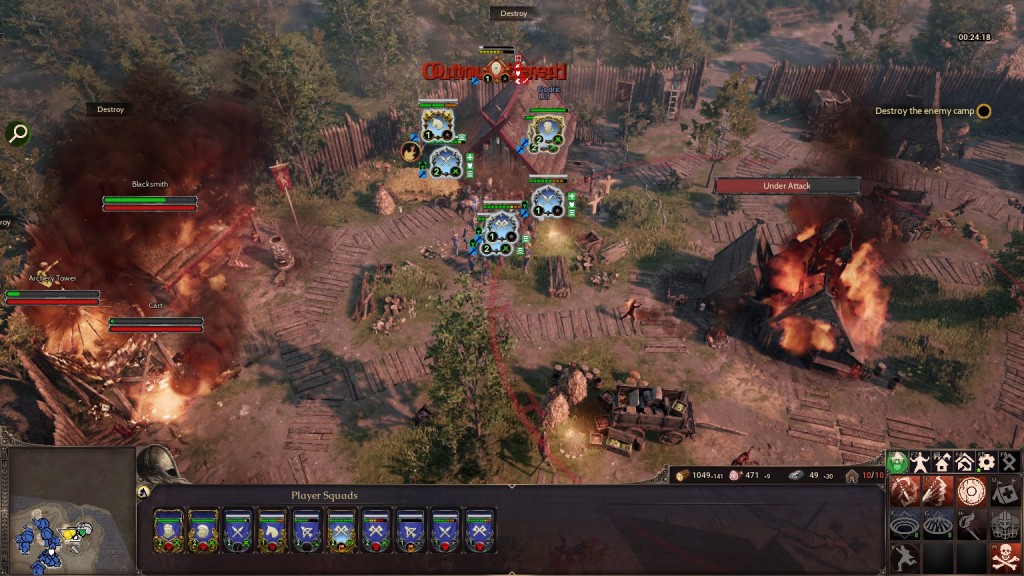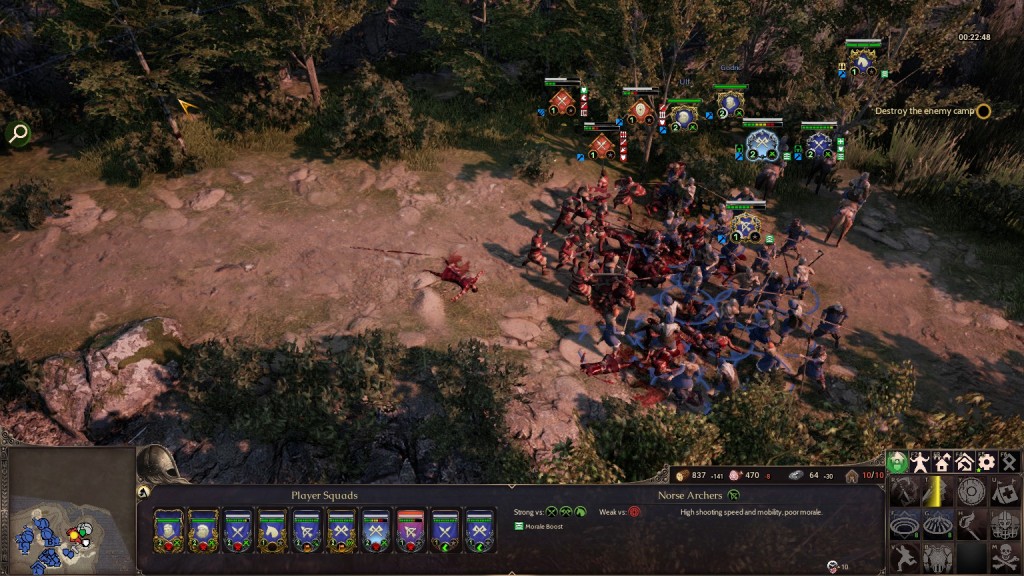I know I’m coming out pretty late with thoughts about strategy games of various stripes, possibly too late for my analyses to be of much use to the players or potential players of these games. Partially, I’m writing these reviews/overviews as a way to brush up on my writing skills. And partially, I’m doing this as a way to organize my thoughts about what these games, and strategy games in general, are doing right and what they could handle better.
I’m a dad of 4 now, and I’ve found that has a way of providing a laser focus in terms of how I spend my energy: without such a focus, I’d rapidly be out of time to enjoy my passions (which of course is the playing and creation of strategy games).
What I have time for, and what you’re going to get out of me, is my take on these games primarily from the perspective of how their systems work: how clear they are, how they empower players to make choices about how to approach the game; how deep they are, to allow players to demonstrate mastery and act in surprising ways to allow understanding of the game to evolve over time and remain interesting, and how they treat the tricky issue of equilibrium, or keeping players in the game and competitive until the game is over. Those are my personal priorities and what I hope to see in any game I play.
Now that we’ve cleared all that up, if you’re still with me, let’s actually start talking about Ancestor’s Legacy
On with the show!

Before I’d ever played Ancestor’s Legacy, I’d heard it described as ‘medieval Company of Heroes’. I find this description to be a little inaccurate. There are some similarities, such as squad-based units and a wealth of active abilities including analogs for mine-laying, but it doesn’t really capture the whole flavor of the game. For me, Ancestor’s Legacy (my hands keep typing Ancestory and it’s absolutely murdering me) is the bastard child of Total War’s tactical battles and Company of Heroes.
When it comes down to it, there’s a specific feeling involved in fighting in Total War. Giant squads stand in a blob and plink away at at each other, slowly winnowing down their numbers as specialists wreak havoc in specific areas of the battlefield. This is very different to how positional combat is in Company of Heroes, and the speed at which squads and tanks can melt away under fire. In Company of Heroes, cover is king and things can do down fast and hard in a way they don’t really in Total War (at least, in my experience. But I’m a relative novice to Total War games and have only started to gain an appreciation for them in recent years).
In Ancestor’s Legacy, you have a bit of both. Basic fighters entangle in melee and tend to just… sit there, beating on each other. Combat ‘lock’s a troop in, meaning there’s little maneuvering possible once a squad has engaged.
The initial hit where squads meet is highly important, as many infantry abilities tend to happen on approach: charges, flanking (an important status effect that can REALLY speed up how quickly a squad dies), axe-throwing, that sort of thing all tend to happen right at the initial encounter. A pinch of COH and a dash of Total War. It takes a bit of getting used to, and status effects can be frustratingly unclear, but once I got used to it, I started appreciating the system a lot more.
I could go on about combat for a long time. During battle, things slow down a bit, but the fun and skill in setting up that initial engagement is highly entertaining. Throwing axes while charging, setting up ambushes, traps… that’s just the start of it. Because if you’re smart, you can game the system.
Ancestor’s Legacy features a dual-stage retreat function unique to the game. The first press of retreat, the unit disengages from combat and runs about a screens-length back toward the player’s base. If you retreat AGAIN, you get the standard, Relic-inspired full retreat. That alone adds a lot of depth to combat, especially when you factor in how important engaging (or in this case, re-engaging) can be to battle. There’s a lot of counterplay to clashing, and a lot of it comes from dictating the terms of each engagement.
In a lot of ways, it feels mechanically and functionally akin to unit maneuvering in Warcraft 3: running a squad out of melee then ducking them back in to maintain their DPS and allow another target to start soaking up damage. But in Ancestor’s Legacy, there’s the benefit of having a consistent system for getting the most out of squads, as well as the advantage of being able to re-engage and use those on-approach abilities again.
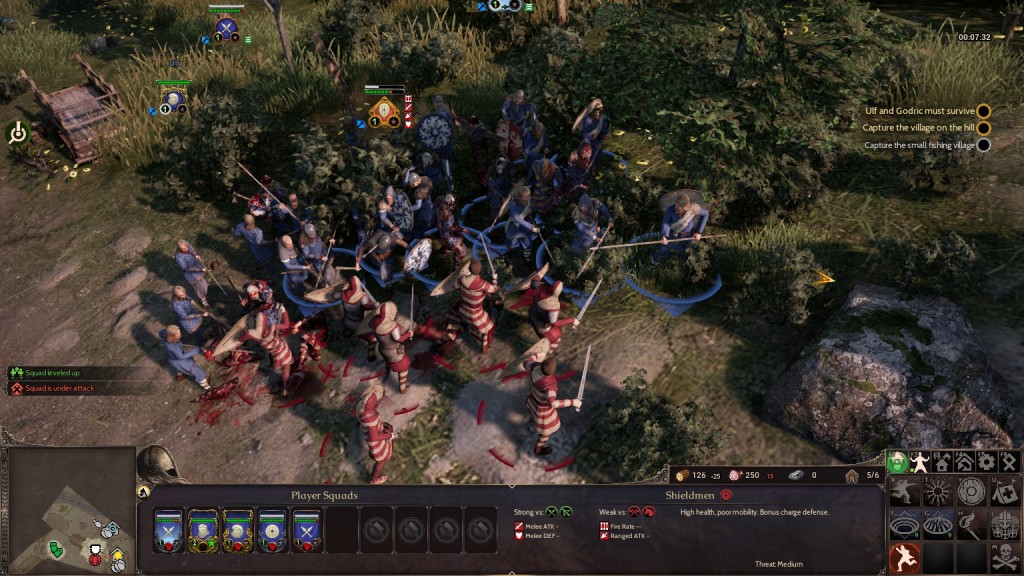
It definitely needed to grow on me though. The first campaign mission forces the player to slog through a couple of fights where they just watch people beating on each other, and it’s not until the second or third mission where the system is unpacked enough for players to truly appreciate the ins and outs. Perhaps this was necessary: there is a lot to unpack regarding hiding in tall grass, active abilities, flanking, traps, and more. But first impressions matter too. This is where RTS with simpler interaction systems, like Command and Conquer, really shine: the basics are easier to grasp and are less likely to turn off players. But I digress.
I wrote in my last review that Close Combat: The Bloody First had a lot of obtuse mechanics. That’s not really the case here. The basic elements themselves are understandable and enjoyable and the player’s toolbox is easy enough to understand and manipulate: there are understandable rules of engagement that are easy to ingrain in the memory. That first impression is a little rough though: several of my friends mentioned similar first-blush experiences that left an impression.

Overall, combat gets great marks for me. It’s deep and has a lot of nuance, fun edges to play around with to get the advantage over your opponent. You just have to be patient and push through till you’re presented with all the pieces (speaking about the campaign here).
Another thing: the tactical aspect of the game are remarkably clear. This was a breath of fresh air for me after feeling like I’m flailing to understand the ‘under the hood’ systems in games like Battlefleet Gothic: Armada 2 or Steel Division 2. Once you’re inside of the game’s logic there’s not really anything that’s hidden or obscured, and it’s possible to just focus on getting the most out of your squads. Even the tradeoffs for armor (armored squads move slower, leaving them more vulnerable to ranged units and to take additional attrition while on approach to the enemy) and upgrades are very clear and understandable.
One last note: The unit veterancy system is very well done. Units can choose a specialization as they level with clearly defined pros and cons. Extra speed, extra defense, extra attack. It’s a lot more interactive and feels more meaningful than veterancy systems in C&C3 or Company of Heroes (personally. There’s good cases both ways: in COH2, it’s really clear how a squad of a given veterancy level will behave in combat. This leaves it a bit more ambiguous to the players).

Now, let’s talk about basebuilding and map control.
Bases Loaded!

Basebuilding, another thing that Ancestor’s Legacy takes a little while to show you, is just really smooth. First off, you need to understand that there’s a big difference between the player’s home base and the secondary bases or control points on the map.
While your main base trains your troops, replenishes your squads, and contains your upgrades, towns also exist on the map. These are part control points, part defensive points, and partly your means of acquiring resources.
I actually really like this: you get the base-building that most players want in RTS but it’s more along the lines of Company of Heroes or Dawn of War where it’s not one of your main focuses. Maybe half-way between COH2 and traditional COH? Anyways, it’s slick and I like it.
There’s a bit of… clunkiness to it? Not much – I almost hesitate to bring it up. I think it comes from the tech tiers: as in Company of Heroes 2 or in Age of Empires games, some buildings, upgrades, and units are locked into a Tier 2 and Tier 3 that you have to open up. It doesn’t feel very medieval, and kind of breaks up your progression through the tech tree.
Anyway, it’s hardly a complaint. It’s honestly pretty elegant and simple enough to not excessively overwhelm players unfamiliar with RTS while providing meaningful choice (and targets) to RTS veterans. It’s not gonna appeal maybe to players who crave building 28 Barracks to pump out marines ad infinitum, but it’s a really well done system for a tactically focused game.
Destructive Creations did an admirable job of taking the complexity of the base and streamlining it. I do wish that towns could take a tiny bit of the load from the base, given how large maps can be in the game. Having to run from the front-lines back to your basecamp to replenish squad members gets a little brutal.
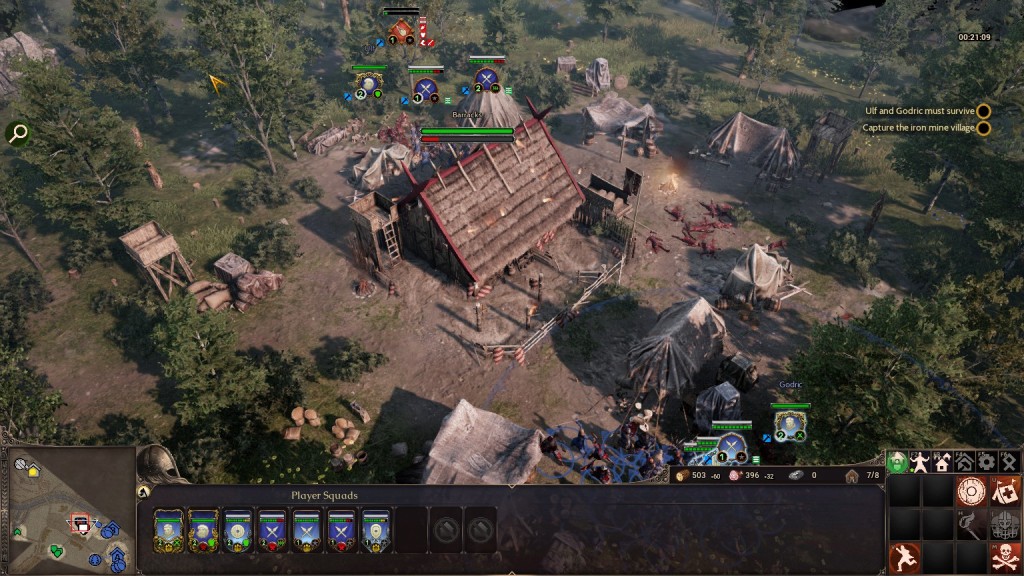
Treating towns as control points is absolute fucking genius, pardon my French. It’s a phenomenal system and I cannot say enough good about it.
Each town is connected to various resource deposits: farms, mines, lumberyards: that sort of thing. Automated peasants are trained to staff those sites as you unlock and upgrade them via your town hall. It keeps the focus on combat, but leaves infrastructure harrassable, since a town is really 4 separate objects that interact and there’s a good amount of space between the town and the resourcing it supports. Mechanically, it’s actually kind of similar to Grey Goo, but it *feels* a lot better. I’m probably one of the only people who’d make that comparison.
But the FEEL of the town is stellar. It’s way more meaningful and understandable than a flag on the map (that’s what Company of Heroes does). Just, well done. And for my money, adding more micro-management to either the town or the base would just muddy up the game. I feel like a lot of work went into the balance around how hands-on these systems should be, and it pays of in my humble opinion.

Conquering towns and destroying bases is perhaps one of the most fun systems in all of RTS. Each town has a town hall, and that town hall serves as a control point. Destroy it, and it rebuilds itself under your control. A little unrealistic in a game that lets you watch burning villagers roll around on the ground as their skin blackens? Maybe a bit. But it does the trick.
The best part though? In games like Age of Empires, your soldiers whack on straw huts and wooden castles with swords until… they catch on fire. That ain’t for me, says Ancestor’s Legacy. No, when targeting buildings, units whip out fire arrows or pull out burning torches to literally burn down the motherfreaking buildings.
It’s an absolutely delightful touch both visually and mechanically, and it allows for buildings to have a completely different type of HP from units, and a completely differently feeling interaction. It’s lovely and perfect and everyone should steal this (unless you go with capturing buildings as in Command and Conquer. That’s your other option, you Philistines).
Final Thoughts
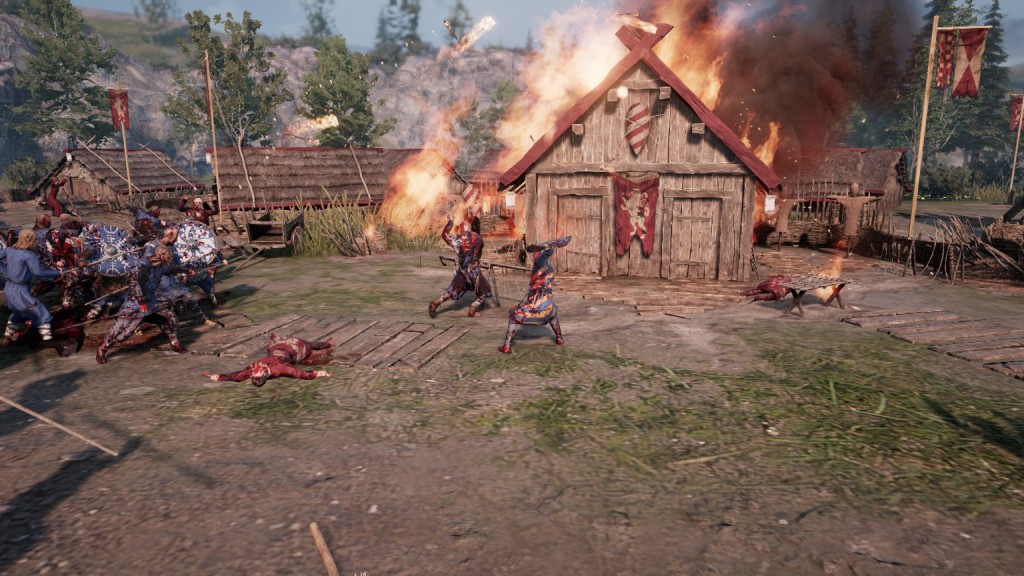
With all that I’ve said good about Ancestor’s Legacy, you might be asking: what’s the catch? What are the weak spots?
Well, in my opinion, there aren’t many.
I already talked about how you kind of have to wait to have the game unfold for you all of the mechanics before you can really master them. There’s the weird feeling of clunkiness in the town/base interactions.
Maps are a bit large for the number of squads you can field, making things drag on a bit. There are a couple of rough edges where the more serious, grim systems bang up weirdly against more game-y systems. Resource harvesting feels a bit over-automated since you don’t do much besides build the harvesting camps to let villagers take care of it for you. I feel almost hypocritical for not minding the automated nature of harvesting, since I knocked Grey Goo and Act of Aggression for their highly automated workers: maybe it works better because Ancestor’s Legacy is a more tactical game? Maybe it works better because of how tightly thematic is it? You got me.
Lastly, the faction differences feel more like something from Age of Empires than Company of Heroes. Different factions mostly get a different subset of units, buildings and upgrades. It’s not a bad system, but I’m a sucker for asymmetrical battle. Again, all of these complaints are nitpicks. I don’t feel like I have many substantive issues with the game. It’s really, really good.
I wish I had gotten into it sooner. As far as I can tell there’s not really a multiplayer community for it? I’ve been a bit chicken to get my pride drubbed by multiplayer in general lately, but knowing that it’s an option is always a plus.


